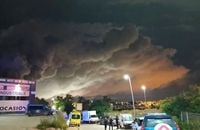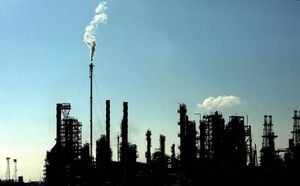On May 10, 2025, a toxic chlorine cloud spread over parts of Spain, leading to a lockdown for as many as 160,000 people. Authorities warned that a fire at an industrial property storing pool cleaning products had released the gas over a wide area south of Barcelona. The incident occurred in the coastal city of Vilanova i la Geltrú, approximately 26 miles from the cosmopolitan capital of Spain’s Catalonia region.
The blaze, likely caused by a lithium battery, ignited at around 2:30 AM. Spanish authorities issued a mobile alert to the affected population, advising them to remain indoors until the toxic fumes dissipated. The Civil Protection service emphasized on social media, "If you are in the zone that is affected do not leave your home or your place of work." As of the latest reports, it remains uncertain how long the lockdown will last as firefighters continue to battle the flames.
By 5:30 AM, most residents in Vilanova i la Geltrú received alerts on their mobile phones urging them to stay indoors. Local media outlets reported that the toxic cloud had enveloped not only Vilanova i la Geltrú but also impacted at least five surrounding municipalities, including Calafell, near Tarragona. The total number of individuals affected by the confinement was estimated to be around 150,000, with no casualties reported at that time.
As the situation unfolded, residents expressed their concerns. Òscar Caballero, a local resident, remarked on the eerie atmosphere, saying, "It feels like we are living through the pandemic again; the streets are empty." Meanwhile, firefighters were still working to control the fire by 8:00 AM, with the authorities confirming that the flames had been brought under control, but the toxic vapors were still being monitored closely.
The health risks associated with chlorine gas exposure can range from mild irritation to severe respiratory distress and even death, depending on the concentration and duration of exposure. Initial symptoms often include burning sensations in the eyes and throat, while higher concentrations can lead to coughing, breathing difficulties, and lung damage. As the toxic cloud expanded, the at-risk area stretched across multiple municipalities from Vilanova i la Geltrú to Calafell.
In response to the incident, transportation in the region was halted, with road closures and train station shutdowns implemented to prevent people from approaching the affected area. The emergency plan against chemical risks was activated, reflecting the seriousness of the situation.
Warehouse owner Jorge Vinuales Alonso spoke to local radio station Rac1 about the challenges posed by the fire. He stated, "It is very difficult for chlorine to catch fire but when it does so it is very hard to put it out." He also indicated that a lithium battery might have sparked the blaze. As firefighters worked tirelessly to manage the situation, they deployed a large number of units to the scene to bring the fire under control.
Mayor Juan Luis Ruiz Lopez of Vilanova commented on the incident, indicating that once the fire was extinguished, authorities expected the toxic cloud to begin dissipating, allowing them to lift the imposed measures. The local government reassured residents that further updates would be communicated regarding when it would be safe to resume normal activities.
As the day progressed, the implications of the incident were felt beyond just the immediate area. Events were canceled, and many residents found themselves confined to their homes, reflecting a sense of unease reminiscent of earlier public health emergencies. The situation served as a stark reminder of the potential dangers associated with industrial accidents and the importance of emergency preparedness.
Overall, the incident in Vilanova i la Geltrú highlights the critical need for safety measures and swift responses to industrial hazards. As authorities continue to monitor the aftermath of the fire and the toxic cloud, the community remains on high alert, waiting for the all-clear signal that will allow them to step outside once again.





